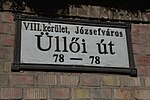The Kőbánya cellar system or cellar system of Kőbánya (IPA: [ˈkøːbaːɲɒ]; in Hungarian: kőbányai pincerendszer, "cellar system of Kőbánya", or kőbányai alagútrendszer, "tunnel system of Kőbánya"), sometimes known to non-Hungarians simply as the Kőbánya Mine, or the Kobanya Mine, is an extensive network of subterranea, or underground spaces, in the 10th district of Budapest (Kőbánya), in Hungary. It is considered to be the largest cellar complex in the country. The complex as a whole started as an underground limestone quarry in a wine-growing area of present-day Kőbánya in the Middle Ages. Later wineries and beer breweries were established on the premises and they continued to use some of the underground spaces. During the Second World War, the dimensions of the complex enabled it to be used as a covert aircraft engine assembly plant and a civilian hideout. Since 2008, Kőbánya Asset Manager Jsc. organizes free guided tours annually (during Saint László Days), which introduce visitors to both the complex and the Havas Villa (erroneously also known as the Dreher Villa), one of the most notable properties connected to it. The underground complex is one of the locations that are participating in the European Heritage Days.The floor area of the complex is variously estimated to be somewhere between 180,000–220,000 m2 (1,900,000–2,400,000 sq ft; 44–54 acres) and the combined length of the tunnels is estimated to be around 32–35 km (20–22 mi). Corridors 3–6 m (9.8–19.7 ft) wide and halls 10 m (33 ft) high are common in it. The deepest part is approximately 30 m (98 ft) under the ground surface. The nature of limestone makes the spaces of the complex moist and moldy, and some parts are actually heavily flooded by groundwater. Currently the bulk of the tunnel system is the property of the Kőbánya district government (through its company Kőbánya Asset Manager Jsc., Kőbányai Vagyonkezelő Zrt.), a small portion is still owned by the Dreher Beer Breweries, who still actively uses some of the cellar spaces, and other small areas are in use by wineries. As of 2007, the Kőbánya tunnel system was not under architectural protection. The complex is sometimes referred to as an "underground city" or as an "underground world".









